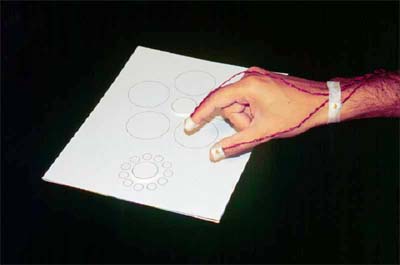

 The distinction that David Milner and I proposed between vision for perception and vision for action predicts that visually guided movements should be largely immune to the perceptually compelling changes in size produced by pictorial illusions. Salvatore Aglioti, Joe DeSouza, and I demonstrated that this was the case using a 3D version of the Ebbinghaus illusion. We showed that despite the large effect the illusion had on perceptual judgements of size, there were only small effects of the illusion on grasp scaling. Nevertheless, some have argued that the small effect on grasp implies that there is a single representation of size for both perception and action. We have shown that 2D pictorial elements, such as those comprising illusory backgrounds, can sometimes be treated as obstacles and can thereby influence the programming of the grasp. The arrangement of the 2D elements commonly used in previous studies examining the Ebbinghaus illusion could therefore give rise to an effect on grasp scaling that is independent of its effect on perceptual judgements, even though the two effects are in the same direction. We have recently demonstrated that when the gap between target and the illusion-making elements in the Ebbinghaus illusion is equidistant across different perceptual conditions, the apparent effect of the illusion on grasp scaling is eliminated.
The distinction that David Milner and I proposed between vision for perception and vision for action predicts that visually guided movements should be largely immune to the perceptually compelling changes in size produced by pictorial illusions. Salvatore Aglioti, Joe DeSouza, and I demonstrated that this was the case using a 3D version of the Ebbinghaus illusion. We showed that despite the large effect the illusion had on perceptual judgements of size, there were only small effects of the illusion on grasp scaling. Nevertheless, some have argued that the small effect on grasp implies that there is a single representation of size for both perception and action. We have shown that 2D pictorial elements, such as those comprising illusory backgrounds, can sometimes be treated as obstacles and can thereby influence the programming of the grasp. The arrangement of the 2D elements commonly used in previous studies examining the Ebbinghaus illusion could therefore give rise to an effect on grasp scaling that is independent of its effect on perceptual judgements, even though the two effects are in the same direction. We have recently demonstrated that when the gap between target and the illusion-making elements in the Ebbinghaus illusion is equidistant across different perceptual conditions, the apparent effect of the illusion on grasp scaling is eliminated.
Recent experiments by David Westwood and myself have shown that grasping is also insenstive to size-contrast illusions that are present in haptics (active touch).
Aglioti, S., DeSouza, J., & Goodale, M.A. (1995). Size-contrast illusions deceive the eyes but not the hand. Current Biology, 5, 679-685.
Haffenden, A.M, & Goodale, M.A. (2000). Independent effects of pictorial displays on perception and action. Vision Research 40, 1597-1607.
Haffenden, A.M., Schiff, K.C., & Goodale, M.A. (2001). The dissociation between perception and action in the Ebbinghaus illusion: Nonillusory effects of pictorial cues on grasp. Current Biology, 11, 177-181. Download pdf
Westwood, D.A., & Goodale, M.A. (2003). A haptic size-contrast illusion affects conscious size perception but not grasping. Experimental Brain Research (on-line).